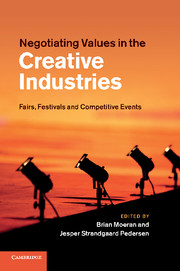Book contents
- Frontmatter
- Contents
- Figures
- Tables
- Contributors
- Acknowledgements
- Introduction
- 1 A Salon’s life
- 2 Art fairs
- 3 Biennalization and its discontents
- 4 Staging auctions
- 5 The book fair as a tournament of values
- 6 Inventing universal television
- 7 Transforming film product identities
- 8 Event institutionalization and maintenance
- 9 Tradition and transformation at the Fan Fair festival
- 10 Between art and commerce
- 11 Configuring sustainability at fashion week
- 12 An inconvenient truce
- 13 The retrospective use of tournament rituals in field configuration
- Afterword Converting values into other values
- Author index
- Subject index
- References
2 - Art fairs
the market as medium
Published online by Cambridge University Press: 25 October 2011
- Frontmatter
- Contents
- Figures
- Tables
- Contributors
- Acknowledgements
- Introduction
- 1 A Salon’s life
- 2 Art fairs
- 3 Biennalization and its discontents
- 4 Staging auctions
- 5 The book fair as a tournament of values
- 6 Inventing universal television
- 7 Transforming film product identities
- 8 Event institutionalization and maintenance
- 9 Tradition and transformation at the Fan Fair festival
- 10 Between art and commerce
- 11 Configuring sustainability at fashion week
- 12 An inconvenient truce
- 13 The retrospective use of tournament rituals in field configuration
- Afterword Converting values into other values
- Author index
- Subject index
- References
Summary
Art fairs are industry trade shows where dealers come together for several days to offer specialized work. Souren Melikian, a distinguished art writer and critic, says that art fairs have surpassed auctions as the premier events for buyers in the upper tiers of the market. Other critics have a more jaded view. New York art critic Jerry Saltz calls art fairs ‘. . . adrenaline-addled spectacles for a kind of buying and selling where intimacy, conviction, patience and focused looking, not to mention looking again, are essentially nonexistent’.
The work offered at the best fairs certainly equals in quality and quantity that offered by an auction house over an entire selling season. Art dealers are engaged in an ongoing battle with the branding, money and private dealing of auction houses Christie’s and Sotheby’s. Dealers needed a slingshot to combat Goliath. They needed to find some relative competitive advantage. They found it, not in mergers or blockbuster gallery shows but with branded and heavily marketed art fairs. In this respect, dealers were able to reconfigure the field of art by creating an event, or ‘tournament of values’, that enabled major players in the art world – dealers, collectors, art advisors, curators, museum directors, artists and journalists – to come together in new ways. The start of the twenty-first century was the decade of the art fair, of the market being the medium.
Information
- Type
- Chapter
- Information
- Negotiating Values in the Creative IndustriesFairs, Festivals and Competitive Events, pp. 59 - 72Publisher: Cambridge University PressPrint publication year: 2011
References
Accessibility standard: Unknown
Why this information is here
This section outlines the accessibility features of this content - including support for screen readers, full keyboard navigation and high-contrast display options. This may not be relevant for you.Accessibility Information
- 10
- Cited by
